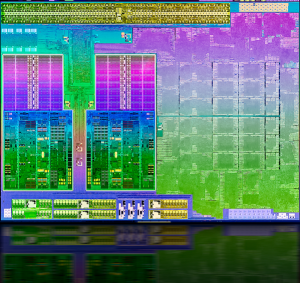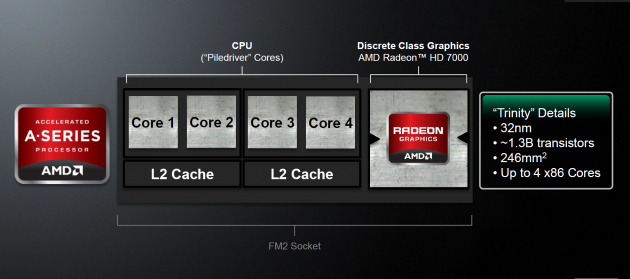 AMD enthusiasts have it hard these days. They have to watch their Intel counterparts gloat, hoot, and holler as Core i7 CPU and gaming benchmarks steamroll their Bulldozers. Even the most die-hard AMD fanboys have had to eat crow and bite their tongues as the much-vaunted FX flagship sank in the harbor, sometimes benchmarking slower than its Phenom II predecessor. It’s certainly not easy to be an AMD fanatic right now.
AMD enthusiasts have it hard these days. They have to watch their Intel counterparts gloat, hoot, and holler as Core i7 CPU and gaming benchmarks steamroll their Bulldozers. Even the most die-hard AMD fanboys have had to eat crow and bite their tongues as the much-vaunted FX flagship sank in the harbor, sometimes benchmarking slower than its Phenom II predecessor. It’s certainly not easy to be an AMD fanatic right now.
But AMD isn’t dead in the water. Their Radeon GPU line is trading back-and-forth blows with NVIDIA in a constant race for the top performer, and their APU line has been getting quite a lot of attention from the price- and power-conscious crowd—particularly in the realms of small form-factor PC builders, HTPC builders, and the like.
AMD’s current trump card is their Trinity platform. Trinity is something we first saw at CES 2012, and it was an impressive demo of a netbook-sized mobile computer running three displays; one gaming, one media encoding, and one playing videos. Three displays, one tiny little APU. Trinity is four Piledriver cores (enhanced Bulldozer designs) paired with a Radeon Northern Islands GPU core.
The question is: will it sell? AMD took a bet with Brazos and Llano, and found that the answer is yes: both platforms sold tremendously well. It turns out that consumers do actually want inexpensive, power-sipping CPUs with decent GPUs paired with them. Sure, the x86 benchmarks don’t really make for a compelling e-peen case, but you can’t argue with the simple fact that these APUs are in a class of their own.
A10-5800K
Today we’ll be looking at AMD’s newest Trinity flagship, the desktop “Virgo” APU called the A10-5800K. We had a brief preview a few days ago that includes the product matrix, since AMD told review sites they could release some information, but today we’re able to spill the beans. If you’ve been following this story, no doubt you know now that pricing and CPU benchmarks have been missing. Let’s get the pricing question off the table immediately. Suggested retail pricing is as follows:
- A10-5800K: Radeon HD 7660D, 100W TDP, 384 shader cores, 800mhz GPU, 4 core CPU, 3.8GHz base/4.2GHz Turbo, 4mb L2 cache, DDR3 1866, Unlocked: $122
- A10-5700: Radeon HD 7660D, 65W TDP, 384 shader cores, 760mhz GPU, 4 core CPU, 3.4GHz base/4.0GHz Turbo, 4mb L2 cache, DDR3 1866: $122
- A8-5600K: Radeon HD 7560D, 100W TDP, 256 shader cores, 760mhz GPU, 4 core CPU, 3.6GHz base/3.9GHz Turbo, 4mb L2 cache, DDR3 1866, Unlocked: $101
- A8-5500: Radeon HD 7560D, 65W TDP, 256 shader cores, 760mhz GPU, 4 core CPU, 3.2GHz base/3.7GHz Turbo, 4mb L2 cache, DDR3 1866: $101
- A6-5400K: Radeon HD 7540D, 65W TDP, 192 shader cores, 760mhz GPU, 2 core CPU, 3.6GHz base/3.8GHz Turbo, 1mb L2 cache, DDR3 1866, Unlocked: $67
- A4-5300: Radeon HD 7480D, 65W TDP, 128 shader cores, 724mhz GPU, 2 core CPU, 3.48GHz base/3.62GHz Turbo, 1mb L2 cache, DDR3 1600: $53
The Virgo line uses a new socket design called FM2. Socket FM2, thankfully, uses the same heatsink mounting as previous sockets FM1, AM3+, AM3, and so on. Motherboard vendors with Socket FM2 boards out the gate include ASRock, ASUS, ECS, Gigabyte, MSI, and SAPPHIRE. There are three new chipsets that support Virgo: AMD A55, A75 and A85X. Each of them include support for AMD Memory Profiles, which enable graphics memory to run at 1866 MHz, with up to a 266 MHz boost.
The sad news for those who bought socket FM1 boards is that yes, you’ll need to go out and buy a new motherboard if you want to upgrade to Virgo.
Temperature and Power
At 4.2ghz under 100% CPU load from Folding@Home for an hour, the APU peaked out at 39C with a Thermaltake Water2.0 cooler on it. Max power draw under load was 115.2w. At idle, this system drew only 33.1w.
The Experience
At $122, AMD is aiming this squarely at Intel’s Core i3-3225. It’s $20 cheaper and has a better integrated GPU. Where the A10-5800K falls apart is in single-threaded CPU performance. Intel still holds a clear advantage, even with their lowest-end Core i3 parts.
Synthetic benchmarks are disappointing for the A10-5800K. Anandtech shows the Core i3 pulling ahead in almost every synthetic CPU-intensive benchmark, but this is not a surprising story. Nobody expected the Trinity APU to make any waves in raw CPU performance.
Where Trinity fits in is a strange question. The oft-touted $500 PC is a good start. With a $122 APU and no discrete GPU cost, you can build a system at close to $500 that can play many games at decent settings, encode and decode video, and act as a perfectly capable, snappy everyday-use PC. Since it’s unlocked (something the Intel counterpart is decidedly not), you can even overclock it a bit. For a few bucks more, you can toss in a discrete GPU that pairs up with the APU for dual graphics that will make many games run well even on relatively high graphic settings. You also get triple-monitor support, although in practical terms that kind of feature is of negligible usefulness since three monitors will outstrip the budget for those who are cost-conscious enough to be shopping for this level of processor anyway. Still, for those who may need it, Eyefinity support is a definite competitive advantage at this price range.
Who is it for?
One use case that intrigues me is for people who use the upcoming crop of GPU-accelerated content creation apps like Adobe Photoshop CS6. OpenCL support is increasing, and Adobe has committed to releasing full Mercury acceleration for Radeon GPUs. The APU is a perfect use case for this kind of application, and while gamers and enthusiasts might not find a compelling case for Trinity, regular Photoshop and Premiere Pro users might be chomping at the bit for a computer at this price range that offers 30-bit video support, OpenCL acceleration, and the multi-display support that this APU offers.
Currently, Adobe Photoshop CS6 has acceleration for a slew of filters. For professional photo editors, the A10-5800K APU is a fantastic processor specifically for this very reason. While it’s not guaranteed, there is a pretty damned good chance that Premiere Pro CS6 will support OpenCL on Windows soon. It’s working on Mac, on the Radeon 6750M, which is a very, very close leap over to Windows support. If that becomes the case, a video editor will be able to build a very inexpensive workstation that uses Adobe Mercury Playback to drastically increase video editing and encode performance.
AMD doesn’t seem to market these chips to content creation professionals at all, which is a shame. These might actually make the perfect workstation processors for a large portion of the low- to mid-range content creation world.
Conclusion
History will probably show Virgo to be a stepping-stone platform. It’s not as intriguing as Llano was, because Llano was very novel. Trinity is an iterative step up from Llano—an important one, but it’s evolutionary. Things will get really interesting in 2013 with Steamroller and even moreso in 2014 with Excavator. For now, Trinity represents an important platform for AMD in a very specific market. People who thrive on benchmark numbers and who want 2 extra FPS in their games are not that market. Pundits and armchair quarterbacks on the web will scoff and snort at Trinity’s less-than-impressive benchmarks, but AMD will still sell a ton of these chips, because they fit exactly where a very large group of people need them to be: inexpensive, and fast enough.
$550 System
- AMD A10-5800K APU from Newegg or Amazon: $130
- Gigabyte GA-F2A85X-UP4 motherboard on Newegg: $130
- G.SKILL Ripjaw 8gb DDR3 1600 on Newegg: $40
- NZXT Source 220 ATX case on Newegg: $60 (review here)
- Seagate Momentus XT 750gb Hybrid SSD on Newegg: $128 (review here)
- Thermaltake 430w PSU on Newegg: $40
What you’ll get with this machine is a system capable of playing many games on low to medium settings at 1080p, high settings at 720p, triple monitor support, plenty of room for expansion (such as a future discrete GPU to really make it a gaming powerhouse), and the ability to overclock with an unlocked APU. You’ll be idling at around 35w and at max load only pulling around 120w.












 Articles RSS
Articles RSS